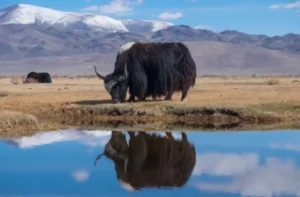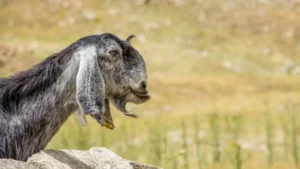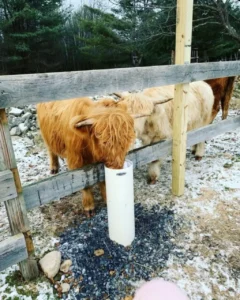Beauty is in the eye of the beholder. We’ve all heard that expression before today. It generally means that our individual notions of beauty are subjective to personal opinions. What one person finds attractive may not be pleasing to another. People have different ideas about what constitutes beauty in the animal kingdom. We’ll investigate three farm and ranch animals that can only be described as – “loveable barnyard misfits”. Please feel free to share your opinions and comments about your own “loveable barnyard misfits” in the comment section below
Loveable Barnyard Misfits
We all have subjective opinions about how “attractive” one breed or another appears to us. Not everyone agrees that horses are majestic, or that sheep are cuddly or that pigs are cute. But there are some farm animal breeds we can all agree will turn heads with their unique looks. Meet the Yak, Belgian Blue, and the Damascus goat. Each breed looks odder than the next. Despite their best effort to blend in on the farm or ranch – they look like complete misfits around other livestock.
The Exotic-Looking Yak

These days – as you investigate pastures and feedlots, you may see one of the latest unique-looking additions to the animal landscape on North American farms – the yak. With its bulky frame, short legs, handlebar horns and shaggy, ground- length dense fur, the yak’s looks can definitely turn heads in the bovine world.
Yaks are closely related to cows and buffalo. They provide their keepers with meat, fiber, and milk. Yak meat reportedly tastes similar to bison meat, through a bit sweeter in favor. As a result, the meat is gaining popularity as a delicacy or specialty meat and commands a healthy price on the market. Fiber from yaks can be woven and the underwool is considered soft and warm like cashmere. Yak milk – though not produced in the same amounts as dairy cattle – is often pink in color and easily converts into yogurt, butter, and cheese. The rich yak butter has also been used by traditional Tibetan shepherds to both polish fur coats and as lamp oil.
Crossbreeding yak with cattle creates an interesting hybrid. The resulting offspring are called dzos. Like mules, the male version of the hybrid is sterile. The female hybrids, called dzomo’s can be “back-bred” to allow three-quarter mixes of cattle and yak. The cattle-yak hybrid demonstrates it best advantages in high altitude, colder climates – like highland areas of the American and Canadian mountain west. The yak’s lung capacity and heavy fur make for a hardier animal, easily allowing these hybrids access to the harsh conditions above 6000 feet.
 Muscular Cattle
Muscular Cattle
Who is that bovine with the body-builder physique? That thicky muscled breed – often called double-muscled – is one of the strangest-looking breeds of cattle on the planet. That’s the Belgian Blue. As the name implies, Belgian Blue cattle originated in central and upper Belgium, during the second half of the 19th Century. In the Dutch language his name is
dikbil – meaning literally “fat buttocks”. Due to selective breeding, possibly with Charolais cattle, these calm animals have extremely heavy, thick muscles. The result yields an approximate 20% increase in the amount of meat harvested from each animal.
Belying their musculature, they remain a fairly docile animal. As a result, this temperament makes them excellent show cattle for clubs and fairs and delivering good results for young breeders. The breed doesn’t come without a few drawbacks. Full-breed Belgian Blues can have some difficulty calving, and most calves come into this world by Caesarean section. Instead of going the full-breed route, many opt to crossbreed the Belgian Blue with other strains of cattle. The result is a 5 to 10 percent increase in muscle fibers for crossbred calves.
Despite breeding concerns, dieticians often recommend Belgian Blue beef thanks to its low cholesterol level, low calories and low-fat content. Producers say it even has less cholesterol than skinless chicken. It also cooks quicker thanks to its reduced fat content.
Funny-Face Goat

The Damascus goat is the next and last stop on our tour of loveable barnyard misfits. Often called the bulldog of goats due to their appearance, the Damascus goat gained a reputation of possessing an almost monstrous appearance. Since the Damascus goat shows a typically different appearance from other goat breeds, breed’s characteristic looks have allowed it to gain popularity throughout the world. This goat has interesting features. It has long, swinging ears measuring 9-12 inches in length. A long head and Roman nose with a long neck is a prominent characteristic. An oversized protruding lower jaw adds to the interesting facial profile of the Damascus goat.
Related to Nubian goats, the Damascus is primarily a dairy goat. Due to its hardy nature, it can produce milk in changing environmental conditions and milk is rich in fat and protein which has made it popular throughout the world. They also serve as meat and hide producers for their livestock owners. Unlike their Alpine cousins, Damascus goats – originating in the Middle East – breed and grow very well in high temperatures and in lowland areas. The Damascus goat is a hardy breed, and there are
no known health issues within the breed. Anyone interested in raising goats should consider this breed, because of the relative ease for caring for these hardy goats. They make excellent starter goats for a new operation.
Loveable Barnyard Misfits Stay Happy, Healthy, and Hydrated with Drinking Post
No matter what loveable barnyard misfits you have on your farm or ranch, you can keep ’em happy, healthy, and hydrated with a Drinking Post. A Drinking Post Frost Free Automatic Waterer provides an unlimited supply of fresh water for your animals year-round. By keeping the operating valve 18 inches below the frostline, water comes to the surface from below the frostline. When the animal is finished drinking, the small amount of water remaining in the bowl drains to below the frostline keeping the Drinking Post operating
frost-free year-round in even the harshest climates.
Durable With a Five Year Warranty
A strong 8-inch exterior sleeve protects our frost-free automatic waterer. The Drinking Post is made of a synthetic plastic polymer which is very strong but has flex when needed. So, if livestock are leaning and rubbing, it will flex with the pressure instead of breaking. Remember, because it’s installed 18 inches below the local frostline, most of the waterer will be supported and protected by ground cover. The best news of all to your bottom line: a new Ultimate Drinking Post comes with a 5-year warranty for all parts – structural and working parts.
Add the durability, convenience, and reliability of Drinking Post Waterers to your operation! If you are considering switching to automatic waterers but don’t know where to start – check out our Ultimate Guide to Automatic Waterers where you’ll learn all about the different types of waterers and the pros and cons of each. You can find the Ultimate Guide by clicking this link:
https://dpwaterer.com/automatic-waterer-guide/
Have more questions about the Drinking Post itself? Check out our FAQ, here:
https://dpwaterer.com/faq/
Don’t forget to leave a comment below and share this post on your socials.

 Muscular Cattle
Muscular Cattle
